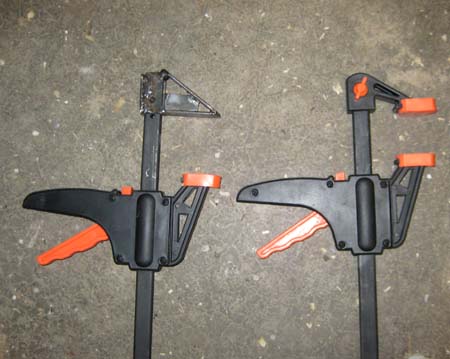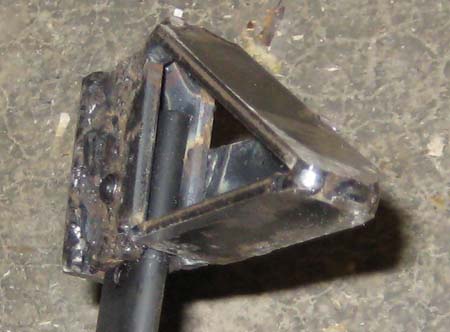|
|
|
garage door physics
Thursday, July 24 2008
Last night I'd done some preliminary gluing of the garage door panel and it had been such a mess that I'd been forced to use every clamp in the shop. I'd made the decision to reuse the panel's inside surface (which is thin sheet of a material similar to masonite) despite the fact that it had been discolored and warped by rainwater. I figured if I used enough glue and clamps, I could avoid the considerable trouble of replacing it (among other things, the pattern of holes on its surface is an important template). In the process of all the clamping, I managed to break a cheap Chinese 24-inch trigger clamp I'd bought from Harbor Freight Tools. It turned out that the ends of this clamp had been made from some sort of plastic containing what looked like tiny glass fibers. Having been made in China and imported under dubious circumstances, I wouldn't be surprised if this clamp had been manufactured entirely from toxic wastes. Still, it had been a useful tool, so this morning I decided to try my hand at fabricating a replacement for the clamp's broken plastic end. My chosen material was steel, specifically bar steel with a cross section of 3/4 by 3/32 inches. Lately I've been using a cheapo Chinese-made AC stick welder instead of my fancy Italian-made wire welder and I've been having more success with my welds. The rigidity of the stick gives me better control (I hate all the random pits and nodules that happen as a motor-driven wire dances randomly across a workpiece). Well within an hour, I was able to manufacture a very solid end for my clamp, and it fit perfectly as well. I can't describe how empowering it is to be able to successfully build useful objects from scratch based on a model.

Trigger clamps. The original is on the right and the one with my replacement end is on the left.

Detail of the replacement end I fabricated.
I spent much of the rest of the day finishing the garage door reconstruction, a process that concluded with me painting its outside brown and its inside white. When it was done, I was far from finished. I still had to attach it to its siblings and get the garage door working again.
In physics, a garage door is an unusual object. When it is attached to a spring, it's fairly easy to move and one doesn't spend much time considering its weight or momentum. But without its spring, a garage door is most unusual. What with all its panels, I'd venture to say that a garage door ends up weighing nearly as much as a mid-sized woodstove. But because of the articulations between the panels and the L-bend in the track that it runs in, an unsprung garage door weighs less and less the higher you raise it. But when it's in this position it is extremely dangerous. Should anything cause it to roll over the bend in the track, it would fall with enormous momentum. I hadn't thought of any of this when I'd unsprung the door and removed its bottommost panel. In fact, I'd left the rest of the door at the top of its track, oblivious to the danger it posed in that position should anyone be tempted to give it a little westward nudge.
Today, though, I became intimately familiar with the danger and power of an unsprung garage door. My schooling began when I went to lower the rest of the door down onto the restored panel, the prerequisite for bolting it to the chain of panels. I made the mistake of lowering the door with my fingers beneath it, and they quickly became trapped in the narrowing space between the door and the restored panel. Somehow I extricated them, but not without some lingering injuries. Then, once I'd bolted the panel in place, I had to raise the door up so I could reattach the cables that run to the spring. But by now the door was so heavy that I could barely lift it. I managed to raise it about six inches through brute force, but from there I used a farm jack.
After I had the door up high enough to be supported by a five gallon bucket, I figured I could just hoist it up the rest of the way using more brute force. By this point, the topmost panel had turned and was going mostly horizontally, so it seemed the whole door might be light enough and I knew it would only get lighter. But when I tried to hoist the door, I neglected to consider that I'd removed the bottommost track rollers, and this allowed the bottom panel to flap freely. As I was lifting it, I suddenly realized it was flapping outward from the track. Had it successfully done so, all the panels above it would have been unsupported and would have been free to fall, something that might well have crushed me to death. So I fought with all my strength to pull that bottom panel back into alignment. This wasn't easy, since I was fighting against the weight of nearly all of the door. I was successful in doing so (had I failed, you wouldn't be reading this), but in so doing I felt something give slightly in my lower back. It wasn't dramatic, but I knew I'd be paying a price for this for days or weeks to come. Indeed, there was a possibility I'd never completely recover from this for the rest of my life. Happily, I wasn't in any pain, but I was definitely unnerved. Everyone knows you can't take a human back for granted.
To get that door up to where it needed to be, I ended up building a platform using two sawhorses, jacking the door from there to the height of a five gallon bucket plus six inches above it. At that point, the door was light enough for me to haul it the rest of the way using ropes pulling from the top. Once I had it horizontal at the top of its tracks, I tied it in place. Now that I knew what a hazard it was, I took no further chances.
For linking purposes this article's URL is:
http://asecular.com/blog.php?080724 feedback
previous | next |

